10 of the World's Best Lagoons
Sheltered, tranquil and full of shifting colours, lagoons offer exceptional swimming, snorkelling, wildlife-watching and even history. Jo Davey traverses the globe in search of some of the best
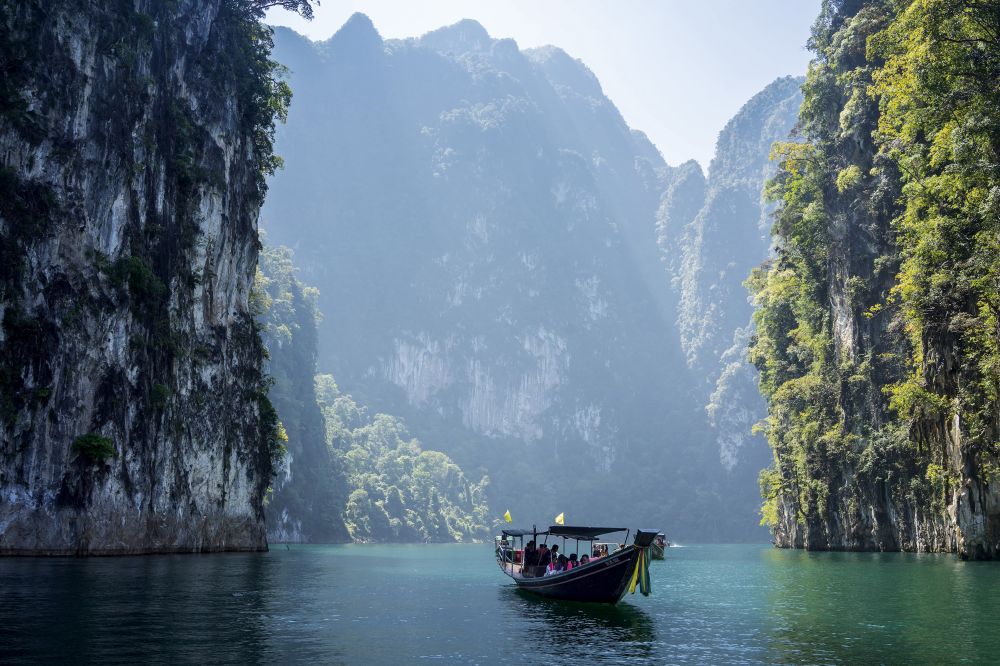
Sheltered, tranquil and full of shifting colours, lagoons offer exceptional swimming, snorkelling, wildlife-watching and even history. Jo Davey traverses the globe in search of some of the best
Sitting like a shark’s tooth in the Andaman Sea, Koh Hong (Hong Island) is part of a national park off Thailand’s southern coast. Finding an unspoilt, crowd-free Thai island is no easy feat, but this Krabi Province paradise is one of the country’s prettiest and most pristine islets. Being so close to crowded Phuket, Hong’s quietness comes as quite the surprise, but its national park designation provides it with government protection from destructive development. The only buildings on shore are a handful of cabins on the island, used by park staff.
The star of the island is its lagoon – a cavity in the island’s north fed by a thin, hidden channel to the sea. The waterway is so narrow only two boats can pass between the soaring cliffs at its entrance, making the lagoon feel truly, delightfully isolated. The waters here are glassy, ranging from turquoise to deep emerald, their ripples rent by huge limestone stacks and pillars that loom over swimmers. The two beaches are perfect for those hoping to settle into soft white sands, but there’s far more than sunbathing on offer.
Koh Hong is a rich ecosystem that makes for brilliant snorkelling, with healthy coral reefs and exceptional visibility. Visitors can also kayak the surrounding mangroves and navigate around the rock formations. If you tire of floating in the warm seas, the small island’s interior offers up the chance to try rock climbing, with a range of routes for differing skills. There’s also abundant wildlife to spot in the vibrant jungle: Koh Hong is home to whitefaced gibbons, superb birdlife and monitor lizards.
There’s no accommodation here so you come here on a half- or full-day trip, usually from nearby Ao Nang on the mainland. Tours are done by both speedboat and more traditional longtail boats, taking 20 and 40 minutes respectively. The island features in a few tours, but to make the most of the lagoon and jungle, opt for a tour dedicated to the Mu Koh Hong archipelago.
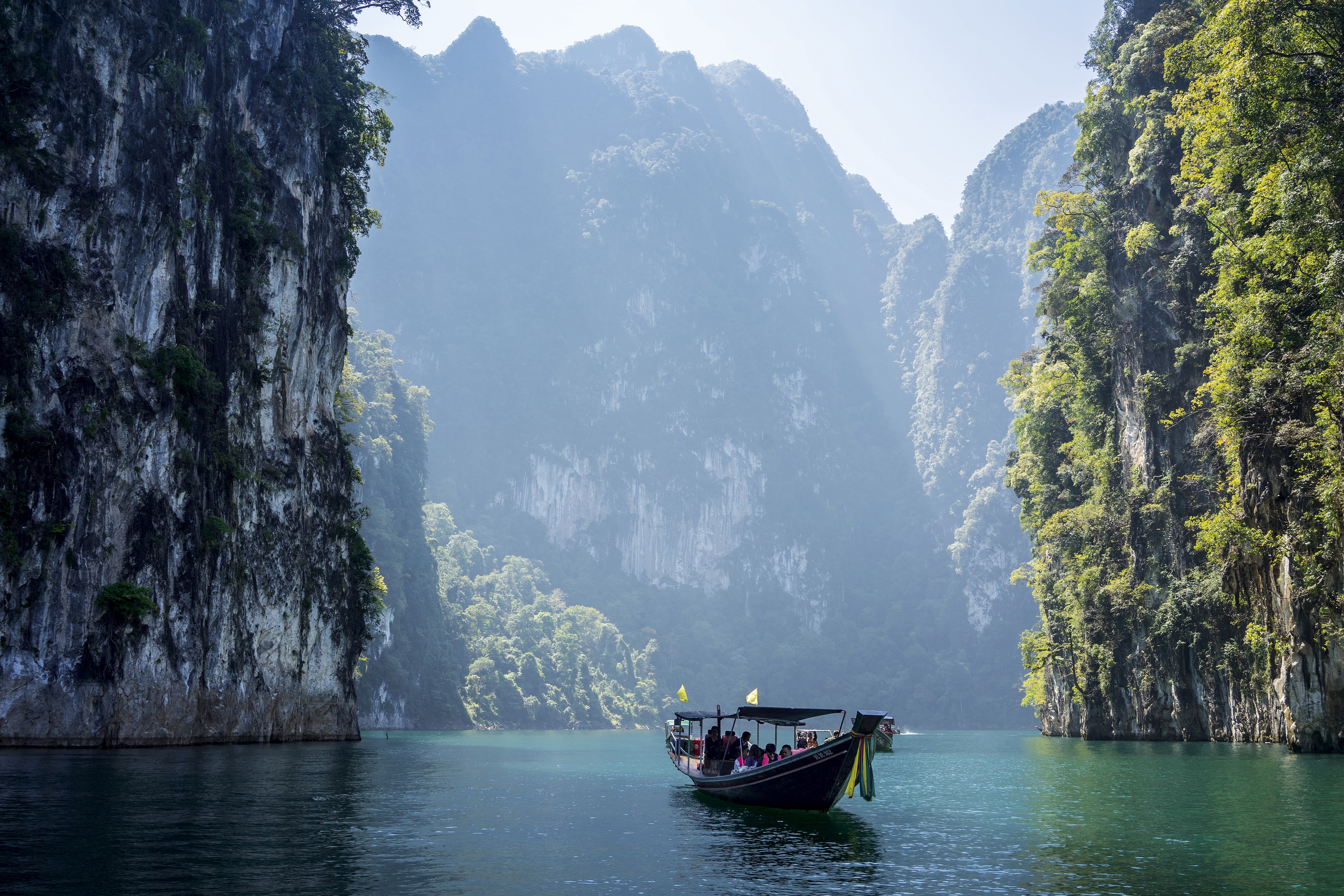
WHERE TO STAY Ban Sainai Resort’s stunning villas are set in lush grounds in Ao Nang. Cottages from £46. bansainairesort.com
Its renown – and appeal – is far-reaching, but it’s easy to forget the canal city sits on a lagoon. A long, slim fence of islands enclose a grey-green swipe of Adriatic Sea and over 100 islands and islets. In total, the area covers more than 70,000 hectares along Italy’s north-east coast.
The protected lagoon, forming a safe space for sailors and locals, helped it to become one of the world’s major ports. Occupying its own island, the city is an architectural marvel that bobs ever closer to the water line. For all its crowds, Venice remains one of Italy’s top destinations for good reason. Gondolas drift along romantic waterways, while on land visitors meander unmapped streets to uncover hidden shops, cafés and lanes lined with history.
Although not the largest, the best-known islands – Torcello, Murano and Burano, scattered to the north-east – form an easy tripartite day trip by waterbus or taxi, each with its own claim to fame. Photos of Burano’s colourful houses fill up phones and cameras, but there’s more to the island than good looks, with its history of lace-making and a large fishing community to supply local restaurants with lagoon seafood. Murano is known for its unique, highly-prized glass art, handmade in front of visitors at its studios; while further north, pretty Torcello offers up ancient architecture for tourists to explore.
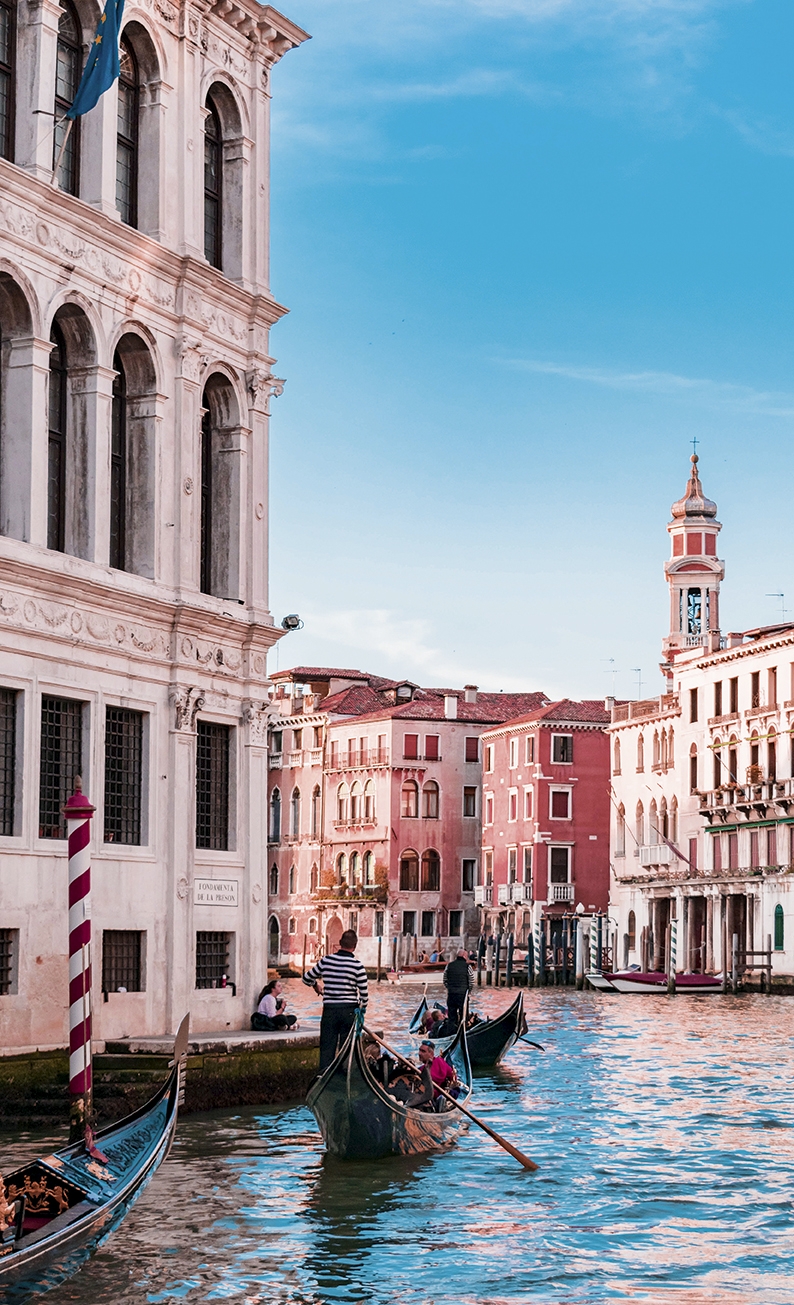
WHERE TO STAY Overlooking the Giudecca Canal, Hotel Il Palazzo Experimental’s 32 design-forward rooms are the perfect jumping-off point for exploring the city by vaporetto. Doubles from £211. https://www.palazzoexperimenta...
It’s difficult to believe the cyan spread of Laguna Lachuá is hidden in the midst of thick Guatemalan jungle. Its bright waters wouldn’t look out of place in an Indian Ocean resort where coral reefs and cocktails are within ambling distance of overwater villas. Instead, Lachuá is a large, little-known cenote just south of the Mexican border, in a national park that takes its name from the magnificent lagoon. Surrounded by animal-filled jungle, Lachuá is entirely unspoilt and off the beaten track. Few people make it out to this lake – after all, getting there isn’t easy. A three-hour drive from Cobán city takes you to the park entrance, where you’ll embark on a hike through the biodiverse forest. It’s worth the effort, although undertaking the journey is hardly encouraged by the translation of Lachuá’s name (in the local language it means ‘fetid water’, a result of its sulphur deposits – thankfully this doesn’t translate into an unpleasant smell). Lachuá is an extraordinarily peaceful getaway where swimmers float in clear waters under imposing mountain scenery, to the calls of Guatemala’s diverse nature. The rainforest here holds tapirs, toucans, monkeys, birds, butterflies and snakes,
ideal for those wanting to combine nature trekking with lazy lakeside days. There are crocodiles too, but the lagoon is so big and clear that there are plenty of safe swim zones for snorkellers. It’s also one of Guatemala’s ultimate picnic spots, its tranquil shores and raised boardwalks making for balmy sunlit lunches.

WHERE TO STAY Bed down at the basic but pleasant and clean Eco Hotel Lachuà in Cobán, a short hop from the park. Doubles from £64. 00 502 3070 0006
Travelling down the long arm of Baja California Sur, the tanned and tawny landscape gives way to Balandra, a grand lagoon bay that’s home to one of Mexico’s best beaches. Carved into the eastern coast, Balandra’s inlet is a 30-minute drive north of La Paz, a charming city of art, beaches and fine parks that also serves as the state capital.
The lagoon beach is nothing short of breathtaking: great pleated folds of cream sand lie just under the translucent shallows, blending out into the Gulf of California’s startlingly bright blue. The panoramic viewpoint above the bay is the best way to take in the scenery, but you can rent kayaks and stand-up paddleboards to take you take across the lagoon or down to the headland towards Balandra’s favourite landmark, a mushroomshaped rock that’s been eroded from the bottom.
Swimming may seem like the main attraction, but the water is so shallow you can walk way out and still only be calf-deep. This makes it perfect for smaller children, but you’ll need to head further towards the lagoon’s mouth to swim properly (there’s no snorkel rental at the beach so if you want to see some sea life bring equipment from your hotel). Among Balandra’s highlights are its stingrays, which like to hide out in the thick soft sands, so keep an eye on where you tread. After your swim, follow the lead of the locals, who come for long picnics, lounging on the peachy sands with plenty of food to hand.
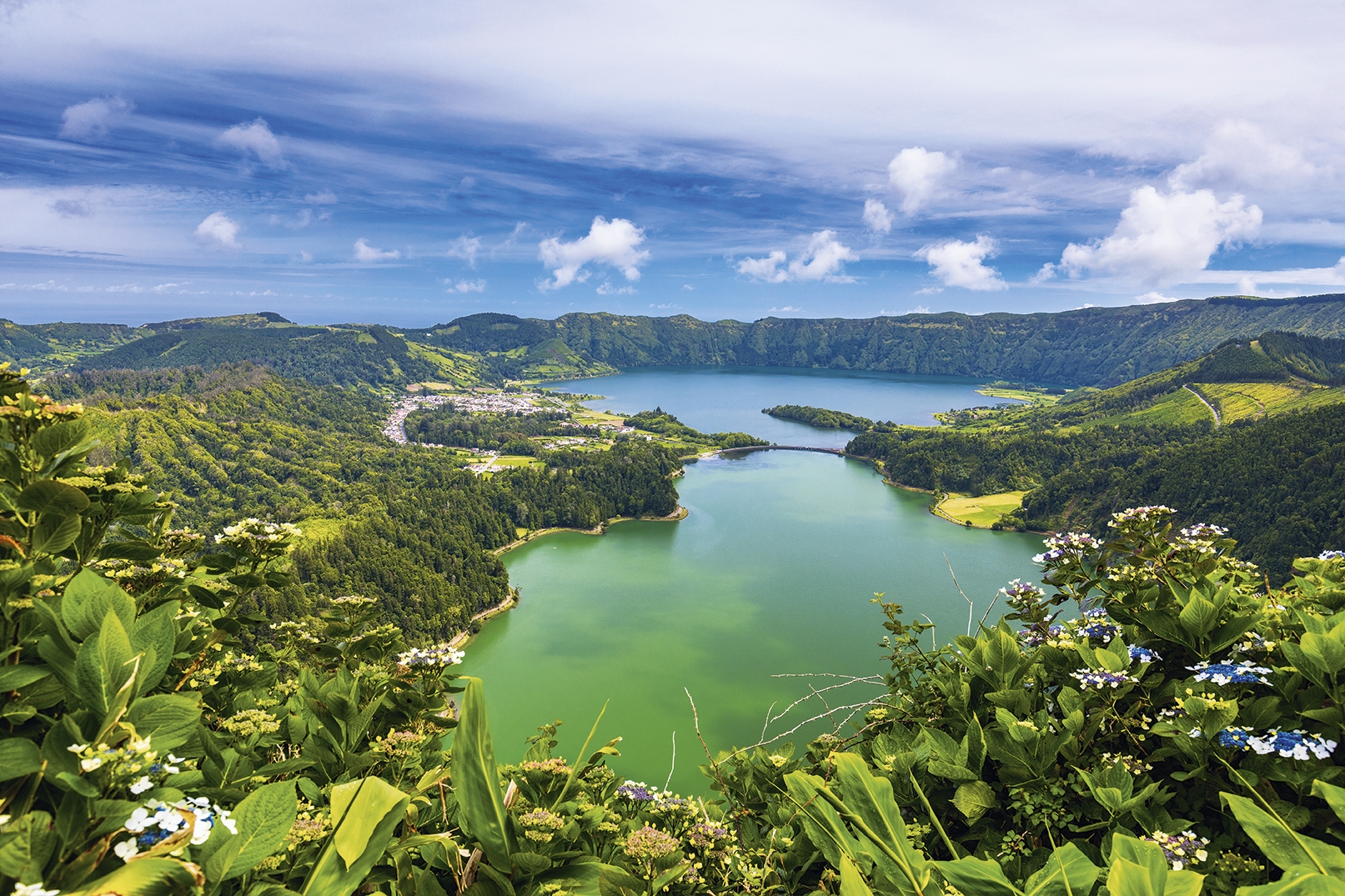
WHERE TO STAY Balandra is an easy day trip from La Paz, where you’ll find the gorgeous Hotel Catedral La Paz with an outdoor pool, city views and chic, contemporary rooms. Doubles from £113. hotelcatedrallapaz.com-hotel.com
Over 1,400km from Portugal’s west coast, the Azores archipelago is a final brief but bold smattering of green on the Atlantic’s way to the Americas. The majority of the islands are given over to nature, with a sprinkling of small cities, terracotta-roofed villages and green fields around their perimeters.
São Miguel is the biggest and most built-up island, but it too has a heart of blue and green, where the Lagoa das Sete Cidades resides. The ‘Lagoon of the Seven Cities’ may be one lake but appears as two different-coloured lagoons, one cerulean (Lagoa Azul) the other celadon (Lagoa Verde). Buried in the 36,000-yearold caldera of a dormant volcano on the island’s west side, the difference in colour is believed to be caused by differences in depth and algae. Or, if you prefer, local legend has it the two lakes came into being when a tyrannical king forbade his daughter to marry a local shepherd. The two forever-parted lovers had their final meeting at the caldera, where they cried enough tears to fill the volcano – one from green eyes, the other blue.
It’s one of the Azores’ best loved sites, easily accessed and ripe with hiking trails and astounding vistas, and it’s an essential habitat for biodiversity: you’ll find plentiful flora and fauna around its shores, such as migratory and endemic birds. You can spot these as you travel the waters by kayak, or explore the surrounding scenery by bicycle or on foot.
WHERE TO STAY Stay close to the lakes at a local guesthouse, or try Sensi Azores Nature and Spa hotel just 3km away. The stylish spa has excellent wellness facilities, including two pools and a hammam. Doubles from £127. sensiazores.com
A couple of hours from the renowned Uyuni salt flats is another Bolivian marvel of colour and creatures. Found in the Eduardo Avaroa National Reserve along the Chilean border, some 4,300m above sea level, is the Laguna Colorada. Literally, the ‘colourful lagoon’, it’s an otherworldly pool of rust red, with great white islands and pink flamingos, backed by Andean peaks. The red comes from algae and sediments, while the white is a result of borax deposits and, as the lake itself is quite shallow, the water colour shifts between brilliant red and deep blue. The flamingos that call it home – including the rare, James’ flamingo, once thought extinct – also get their colour from the red algae, which they eat. The area is also home to 50 species of birds, llamas, alpacas, Andean foxes and pumas. Seeing the Laguna Colorada is easy as it’s a stop on many Salar de Uyuni tours, which are a must in the region.

WHERE TO STAY Tours leave for Laguna Colorada from Uyuni – stay at the extraordinary Hotel Palacio de Sal, built out of salt blocks. Doubles from £145. palaciodesal.com.bo
On the tip of Crete’s north-west promontory, which stretches out across the Mediterranean towards Sparta, is Balos lagoon. This U-shaped pool of pink-white sands and swirling turquoise waters is one of the island’s most popular spots, but it’s far from the tourist track. It takes either a boat or a 30-minute hike to reach, but those on foot are rewarded with remarkable vistas across the lagoon and its sand spit, which connects it to Tigani Island. The surrounding hillsides shelter and seclude Balos, making it feel entirely cut off from the rest of Crete. Although it reaches some 500m across, the lagoon is shallow, making it ideal for non-swimmers and families, but if you’re looking for deeper, cooler waters and snorkelling, head north towards Gramvousa Island. Or while away a few hours trying to spot local wildlife such as monk seals, loggerhead turtles, nesting falcons, shags and cormorants.
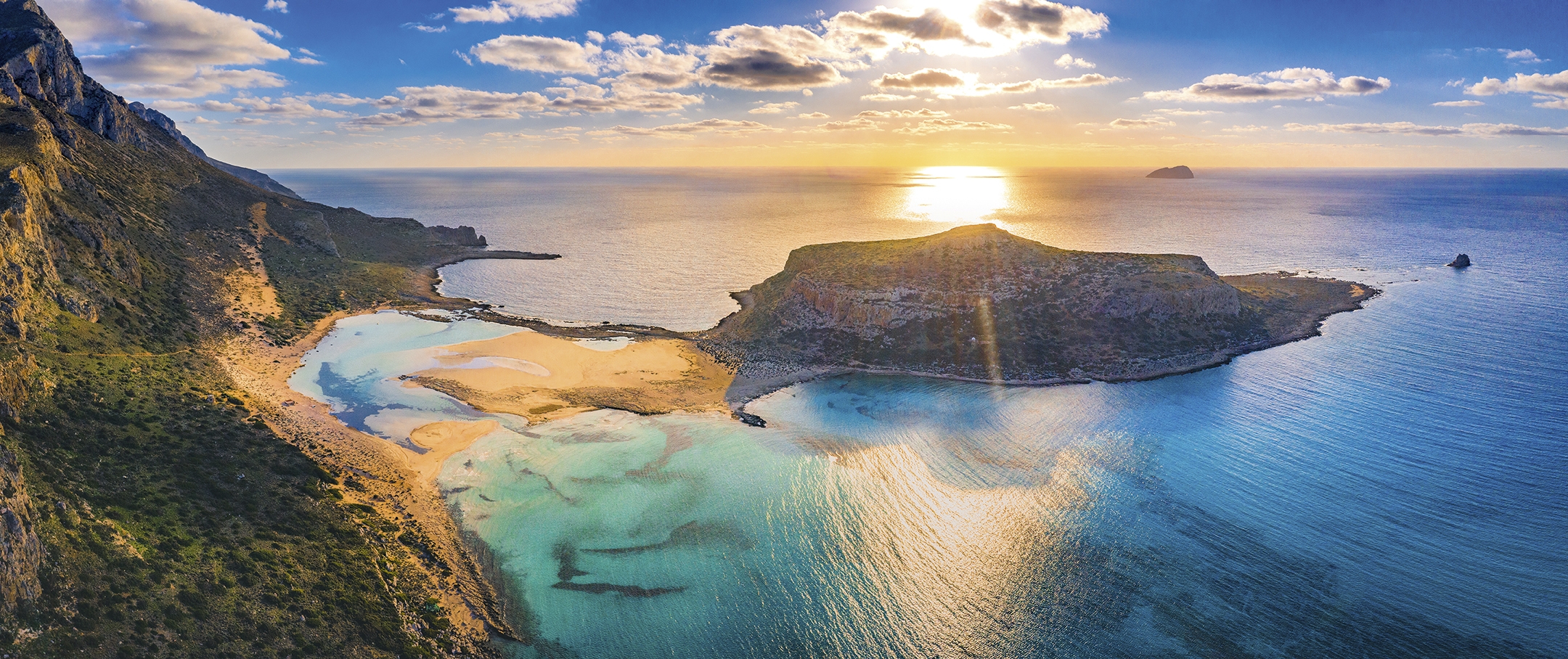
WHERE TO STAY Stylish Balos Beach hotel offers brilliant facilities, suites and studio apartments just north of nearby Kissamos. Doubles from £77. balosbeach.gr
Comino Island hovers like a ball between the outstretched hands of Malta’s main island and northern Gozo. Smaller than its siblings, Comino looks like it should be entirely and overshadowed, but the island has one of Malta’s most beloved tourist spots: the Blue Lagoon. Not to be confused with its namesake in Iceland, Comino’s version is a blissful blue-green playground formed by the Mediterranean and a bank of islets. Its waters are some of Malta’s clearest, shaded towards the shore by golden beaches and dotted by arched rocks and caves. The lagoon is small enough for swimmers to make it out to its largest islet, Cominotto. There’s great snorkelling in gentle, sheltered waters, plus boat rides and animal spotting – the waters often see dolphins and sea lions. Away from the lagoon, visitors can hike the rocky wilds and camp under the stars. The island also has prolific herbs and wildflowers – its name deriving from naturally growing cumin.

WHERE TO STAY There are no island hotels, but you can stay close to the ferry in Mellieħa, at adults-only Lure Hotel & Spa. Doubles from £212 (two-night minimum). lurehotelmalta.com
Something quite magical happens to Lençóis Maranhenses National Park in the rainy season. Its expanse of undulating sand dunes creates a bowl for Brazil’s rainfall, which settles into vast pockets to create temporary lagoons and an ethereal landscape of white and blue. Situated in Maranhão, a state of thick Amazon jungle and coastal desert in the middle of Brazil’s northern coastline, the national park is the largest dune field in South America, perched on the state’s Atlantic edge and covering an astonishing 1,500sq km. The dunes are created by two rivers carrying sand from Brazil’s interior to the coast, where the wind whips the beige sand back inland and up into dunes that top 40m tall. A seemingly endless landscape of white folds gives the park its name: lençóis means bedsheets in Portuguese.
As rainy season (January-July) sets in, the gullies between fill up to provide habitats for wildlife and extraordinary swimming pools for visitors. It’s impossible to walk the white dunes and not want to leap, tumble and run into the cool, refreshing lakes. With such a massive, often interconnected, playground of lagoons, swimming opportunities are unlimited – but there’s the option to explore on horseback, canoe and surf too. The park is also home to mangroves, which can be visited by boat, or you can go tubing in the Formiga river. The easiest way to explore is to grab a guide who will take a buggy or jeep to scale the sands.
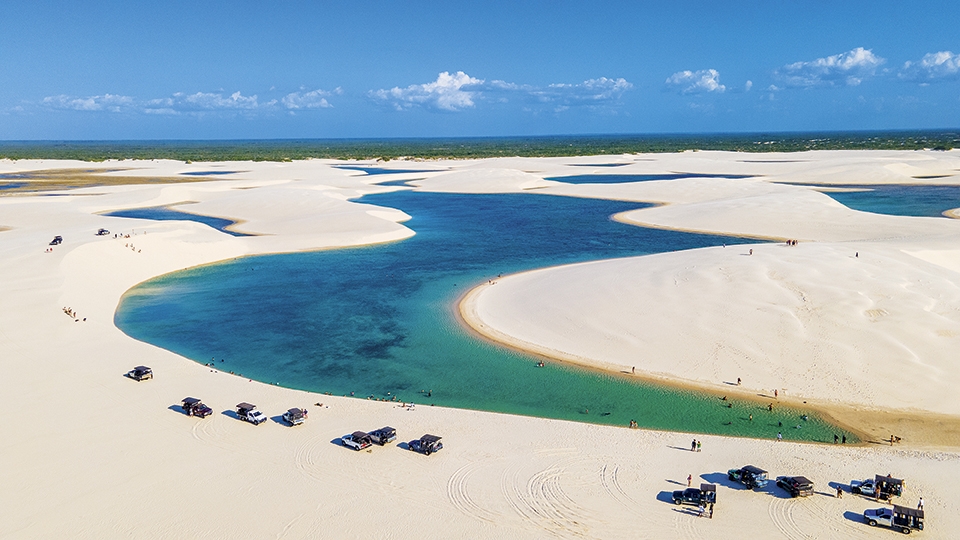
WHERE TO STAY La Ferme de Georges in the village of Atins has luxury lodges that overlook the dunes, and a brilliant restaurant that shows off regional ingredients. Lodges from £155 (two-night minimum). georges.life/en/atins
Seychelles is the poster child for picture-perfect lagoons. The island nation, dappled across the Indian Ocean, comprises a wealth of wondrous pools, lakes and shallows to lose yourself in. Some of its best lagoons are, in fact, entire islands in themselves, forming atolls like Astove, Aldabra and Saint Joseph.
The country is made up of 115 islands, formed from either granite or coral, many of which fall under protected marine areas thanks to their incredible biodiversity. Home to dugongs, turtles and dolphins, as well as blacktip reef sharks, rays, whale sharks and myriad species of pelagic and tropical fish, it’s hardly surprising this is one of the most rewarding snorkelling spots on the planet. Scuba diving options abound too, with multiple wreck dive sites such as the Ennerdale to explore.
For the best experience, start in Unesco-listed Aldabra, one of the world’s biggest raised coral atolls. Covering 155sq km, Aldabra has an extraordinary amount of endemic species, including 100,000 rare Aldabra giant tortoises. To the south-east, the island ring of Astove is popular with fly-fishers and alongside its large fish, Astove’s lagoon is home to terns and green turtles. Further north, nearer to the Seychelles’ main island of Mahé, is Saint Joseph. Cruises to this splendid lagoon show off the boomerangshaped atoll’s nursery for rays, sharks and hawksbill turtles.

WHERE TO STAY One of the best islands for exploring the atolls is Desroches; check into a villa at the ultra luxury Four Seasons Resort Seychelles, with its an on-site marine expert. Villas from £1,430. fourseasons.com/seychellesdesroches
Subscribe and view full print editions online... Subscribe